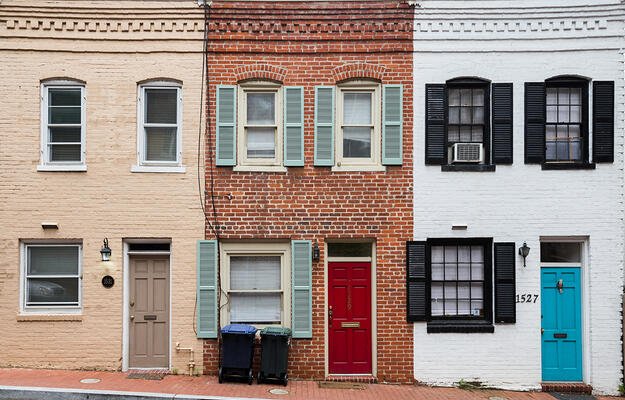
(Christopher Boswell/EyeEm via Getty Images)
Ensuring Safe and Affordable Housing Stock Starts with Understanding Who Owns Rental Units
This post was originally published on Urban Wire, the blog of the Urban Institute.
In late 2021, 15 percent of homes purchased across 40 major metropolitan areas were purchased by investors. Thirty percent of properties purchased by investors in these 40 metro areas across the US were located in neighborhoods where the majority of residents are Black. The increase in institutional investors is sending ripple effects across the housing market, especially for tenants with lower incomes.
Mom-and-pop landlords own a larger share of properties that tend to be more affordable than investor-owned properties, and they serve larger shares of tenants of color. They are also less likely to evict tenants, and their tenants are more likely to struggle to pay rent. Compared with larger landlords and institutional investors, this consolidation of rental market ownership can leave small landlords and their tenants vulnerable.
Understanding who owns rental units is a first step toward ensuring a supply of affordable, quality rental stock—and to supporting landlords—but very little data on rental property ownership exist. To help fill the gap, we used publicly available local data to examine rental property ownership and analyze ownership patterns in Minneapolis and Pittsburgh, as well as in Philadelphia, building on existing analysis. Our analysis of rental property ownership can serve as a model for other cities seeking to target limited resources to small local landlords.
Small landlords own a shrinking share of rental units
Small landlords make up the majority of all unique rental property owners across these three cities, but the share of the market owned by very large landlords (25+ units) varies between cities. For example, we calculated that in Philadelphia, despite very large landlords accounting for only 4 percent of landlords, they own 55 percent of units. In Minneapolis, the discrepancy between the share of very large landlords versus the portion of units they own is even larger: they account for only 5 percent of all landlords but own 70 percent of units.
Large-scale landlords controlling the rental housing supply in certain cities doesn’t come as a surprise. In the past decade, institutional investors have invested an estimated $60 billion into the single-family rental market.
LLC rental ownership decreases ownership transparency, making it difficult to truly understand who owns rental units
Large-scale owners—which are often investors using shell entities like limited liability companies (LLC)s, rather than individuals—make up a large portion of rental property owners. In Philadelphia, grouping properties by the owner name resulted in an estimated 67,000 unique landlords. Grouping by owner address, on the other hand, dropped the number of different landlords to just 44,000. One landlord at the same address can incorporate multiple LLCs, to the point where it’s common to see LLCs incorporated for single addresses.
In addition to this lack of transparency, studies have shown that transition of rental property ownership from individual owners to LLC ownership is associated with increased disrepair in rental housing units, meaning if properties have code violations, it can be harder to hold an LLC accountable than an individual.
LLC Landlords Own a Large Share of Rental Units in Minneapolis, Philadelphia, and Pittsburgh Relative to the Share of Landlords
City | Landlords that are LLCs (%) | Units that are LLCs (%) |
Minneapolis | 16 | 58 |
Philadelphia | 21 | 32 |
Pittsburgh | 17 | 32 |
Source: Author analysis of city property ownership data.
Filling data gaps will help generate solutions that benefit landlords and renters
The challenges small landlords face are different than those larger institutional owners experience. A full understanding of rental ownership across a city can enable planners and decisionmakers to more effectively target resources and implement policies to support small landlords, but to understand the landscape of rental properties, cities first need to collect data on rental properties.
The easiest way to collect these data is through rental registries, and cities should think creatively to ensure small landlords are counted. For example, Newark, New Jersey, used behaviorally informed mailers, which increased mandatory rental unit registration by 454 percent.
Pittsburgh, Philadelphia, and Minneapolis all have some sort of rental registry, and there are data available on rental ownership, which is a key first step in supporting landlords. The next step is applying that baseline data to do more targeted outreach for programs focusing on small landlords.
In Minnesota, the Small Naturally Occurring Affordable Housing program supports the preservation of affordable units through low-cost financing for small landlords and developers of color. In Philadelphia, the Landlord Engagement Program provides incentives for property owners to rent to families and individuals experiencing, or at risk of, homelessness, and the Rental Improvement Fund enables landlords to apply for up to $25,000 toward property improvement. Pittsburgh’s Small Landlord Fund incentivizes small landlords to convert vacant buildings into habitable units.
As the landscape of landlords changes in cities nationwide, it will be increasingly important for municipalities to understand what tools they have to support small landlords and, by extension, their tenants. Having rental registration data equips cities to understand the needs and challenges facing small landlords and provide more targeted assistance and supports.


